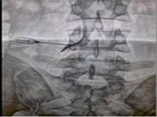Transforaminal Epidural Autologous Conditioned Serum Injection in the Treatment of Unilateral Lumbar Radicular Pain: A Randomized, Controlled, Double-Blind Clinical Trial
DOI:
https://doi.org/10.31661/gmj.v11i.2324Keywords:
Low Back Pain, Intervertebral Disc Degeneration, Interleukin-1 Receptor Antagonist, Autologous Conditioned SerumAbstract
Background: Low back pain could related to disc herniation and managed by surgery. Also, less invasive options, including epidural corticosteroid injection, are available; however, it is associated with side effects. This study aimed to evaluate the effectiveness of autologous conditioned serum (ACS) in treating unilateral lumbar radicular pain. Materials and Methods: In this randomized, controlled, double-blind clinical trial study, a total of 68 patients received the transforaminal epidural injection, 28 patients received ACS, and 30 patients received 40 mg triamcinolone. Under fluoroscopic guidance in anterior-posterior and lateral views, a single injection of ACS or triamcinolone was done via the transforaminal epidural technique. Pain intensity was assessed with a visual analogue scale (VAS) and Oswestry disability index (ODI) at three weeks, three months, and six months. Results: A significant reduction in pain intensity was observed in patients of two groups. There was no significant difference between the two groups during the three months of the study. At the final evaluation at six months, the ACS group showed superiority over the triamcinolone based on the VAS score (P<0.05) and ODI (P=0.007). Conclusions: ACS therapy is a new effective option in treating lumbar radicular pain due to herniated disc. Since no specific complication has been reported, it can be used as a substitute for corticosteroids in such cases.
References
Godek P. Use of Autologous Serum in Treatment of Lumbar Radiculopathy Pain. Ortop Traumatol Rehabil. 2016;18(1):11-20. https://doi.org/10.5604/15093492.1198829PMid:27053305 Becker C, Heidersdorf S, Drewlo S, De Rodriguez SZ, Krämer J, Willburger RE. Efficacy of epidural perineural injections with autologous conditioned serum for lumbar radicular compression: an investigator-initiated, prospective, double-blind, reference-controlled study. Spine (Phila Pa 1976). 2007;32(17):1803-8. https://doi.org/10.1097/BRS.0b013e3181076514PMid:17762286 HS RK, Goni VG, YK B. Autologous Conditioned Serum as a Novel Alternative Option in the Treatment of Unilateral Lumbar Radiculopathy: A Prospective Study. Asian Spine J. 2015;9(6):916-22. https://doi.org/10.4184/asj.2015.9.6.916PMid:26713125 PMCid:PMC4686398 Molinos M, Almeida CR, Caldeira J, Cunha C, Gonçalves RM, Barbosa MA. Inflammation in intervertebral disc degeneration and regeneration. J R Soc Interface. 2015;12(104):20141191. https://doi.org/10.1098/rsif.2014.1191PMid:25673296 PMCid:PMC4345483 Saal JA. Natural history and nonoperative treatment of lumbar disc herniation. Spine (Phila Pa 1976). 1996;21(24 Suppl):2S-9S. https://doi.org/10.1097/00007632-199612151-00002PMid:9112320 Harper R, Klineberg E. The evidence-based approach for surgical complications in the treatment of lumbar disc herniation. Int Orthop. 2019;43(4):975-80. https://doi.org/10.1007/s00264-018-4255-6PMid:30543041 Orhurhu V, Aiudi C, Urits I, Gill JS. Miscellaneous Spine Procedures: Nucleoplasty, Intradiscal Electrothermal Therapy (IDET), and Cryotherapy. In: Spine Pain Care. Springer; 2020. p. 399-406. https://doi.org/10.1007/978-3-030-27447-4_30 Zheng P, Schneider BJ, Kennedy DJ, McCormick ZL. Safe injectate choice, visualization, and delivery for lumbar transforaminal epidural steroid injections: evolving literature and considerations. Current Physical Medicine and Rehabilitation Reports. 2019;7(4):414-21. https://doi.org/10.1007/s40141-019-00244-5 Shin WS, Ahn DK, Kim MJ, Cho KJ, Go YR. Influence of Epidural Steroid Injection on Adrenal Function. Clin Orthop Surg. 2019;11(2):183-6. https://doi.org/10.4055/cios.2019.11.2.183PMid:31156770 PMCid:PMC6526135 Meijer H, Reinecke J, Becker C, Tholen G, Wehling P. The production of anti-inflammatory cytokines in whole blood by physico-chemical induction. Inflamm Res. 2003;52(10):404-7. https://doi.org/10.1007/s00011-003-1197-1PMid:14520515 Evans CH. Novel biological approaches to the intra-articular treatment of osteoarthritis. BioDrugs. 2005;19(6):355-62. https://doi.org/10.2165/00063030-200519060-00003PMid:16392888 Wehling P, Moser C, Frisbie D, Wayne McIlwraith C, Kawcak CE, Krauspe R, et al. Autologous conditioned serum in the treatment of orthopedic diseases. BioDrugs. 2007;21(5):323-32. https://doi.org/10.2165/00063030-200721050-00004PMid:17896838 Lee S, Lee JW, Yeom JS, Kim K-J, Kim H-J, Chung SK, et al. A practical MRI grading system for lumbar foraminal stenosis. AJR Am J Roentgenol. 2010;194(4):1095-8. https://doi.org/10.2214/AJR.09.2772PMid:20308517 Koc Z, Ozcakir S, Sivrioglu K, Gurbet A, Kucukoglu S. Effectiveness of physical therapy and epidural steroid injections in lumbar spinal stenosis. Spine (Phila Pa 1976). 2009;34(10):985-9. https://doi.org/10.1097/BRS.0b013e31819c0a6bPMid:19404172 Kim LK, Kim JR, Shin SS, Kim IJ, Kim BN, Hwang GT. Analysis of influencing factors to depth of epidural space for lumbar transforaminal epidural block in korean. Korean J Pain. 2011;24(4):216-20. https://doi.org/10.3344/kjp.2011.24.4.216PMid:22220243 PMCid:PMC3248585 Nair AS, Kodisharapu PK, Anne P, Saifuddin MS, Asiel C, Rayani BK. Efficacy of bilateral greater occipital nerve block in postdural puncture headache: a narrative review. Korean J Pain. 2018;31(2):80-6. https://doi.org/10.3344/kjp.2018.31.2.80PMid:29686805 PMCid:PMC5904351








